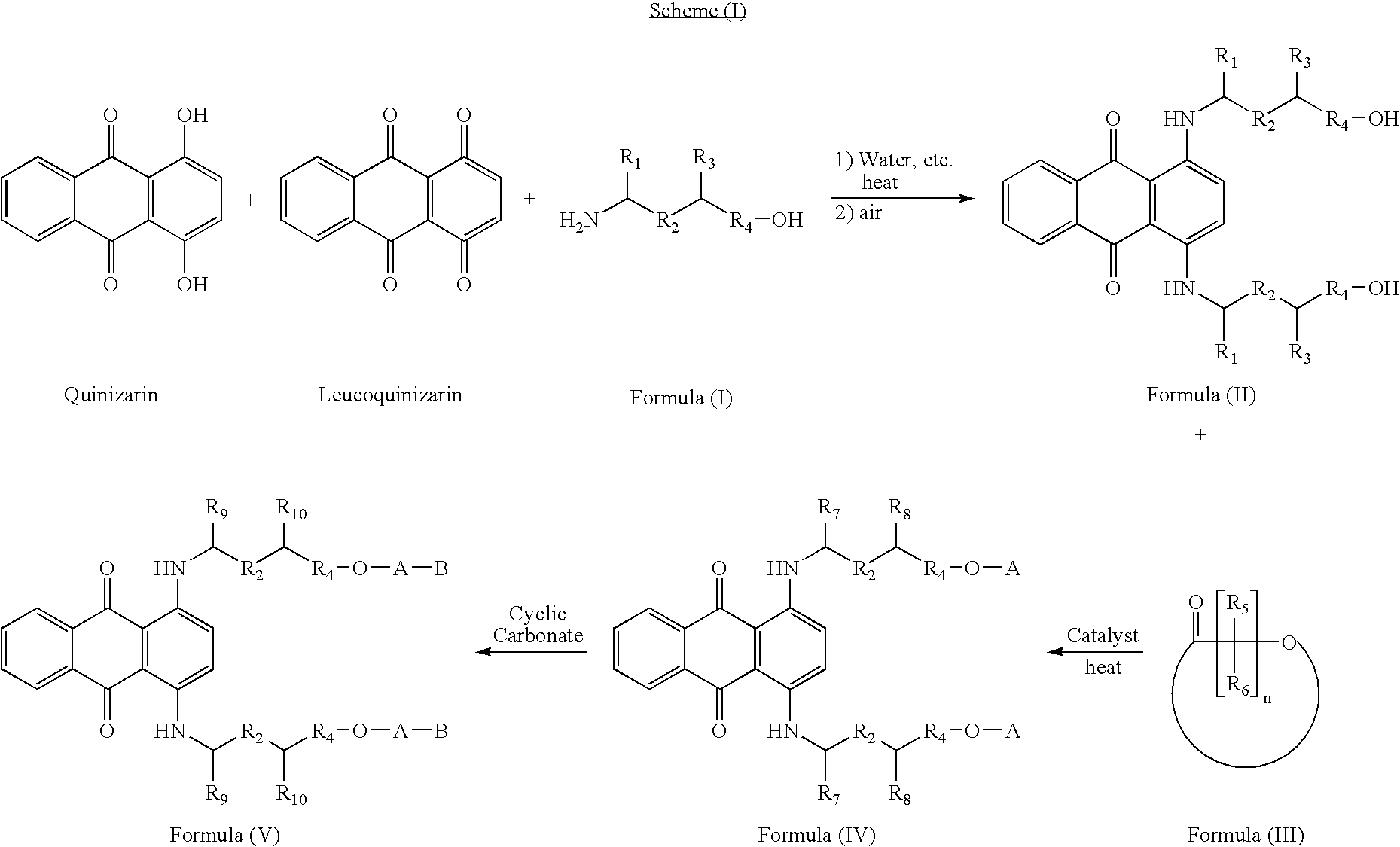Novel method of producing polyesterified liquid anthraquinone-based colorants
a technology of polyester and liquid anthraquinone, which is applied in the field of new polyesterified liquid anthraquinone-based colorants, can solve the problems of color loss and/or degradation, the ability to exaggerate certain problems within the resultant foam, and the limited application of such pigments, dyes, and/or dyestuffs as colorants within polyurethanes
- Summary
- Abstract
- Description
- Claims
- Application Information
AI Technical Summary
Problems solved by technology
Method used
Image
Examples
example 1
[0055] 10
[0056] To a 100 mL 3-neck round-bottom flask equipped with a mechanical stirrer, a thermal controller and a reflux condenser, were charged 8.86 g (37 mmol) of quinizarin, 2.88 g (12 mmol) of leucoquinizarin, 1.0 g (5 mmol) of PEG 200 and 62 mg (1 mmol) of boric acid. 10.0 g (97 mmol) of 2-amino-1-pentanol and 30 mL of water were added under nitrogen and the reaction was heated to 95.degree. C., and monitored by UV-vis. The reaction was complete (UV-vis in MeOH, Abs. .lambda..sub.591 nm / .lambda..sub.637 nm=0.82) after 17 hours of heating. 10 g (20 mmol) of Fomrez.RTM. 11-225 (Witco) was added. The reaction was oxidized by air for 14 hours while the temperature was kept below 75.degree. C. Then the temperature was raised to 120.degree. C. for 1.5 hours and the water was removed under vacuum. The reaction mixture was then charged with 23 g (200 mmol) of .epsilon.-caprolactone and 0.07 g of Ti(OBu).sub.4. The mixture was heated to 120.degree. C. under air for 27 hours. 48.7 g o...
example 2
[0057] 11
[0058] To a 1000 mL 3-neck round-bottom flask equipped with a mechanical stirrer, a thermal controller and a reflux condenser, were charged 72 g (0.3 mol) of quinizarin, 24.2 g (0.1 mol) of leucoquinizarin, 10 g (50 mmol) of PEG 200 and 0.24 g (4 mmol) of boric acid. 72 g (0.81 mol) of 2-amino-1-butanol and 200 mL of water were added under nitrogen and the reaction was heated to 95.degree. C., and monitored by UV-vis. The reaction was complete (UV-vis in MeOH, Abs. .lambda..sub.590 nm / .lambda..sub.639 nm<0.81) after 20 hours of heating. 100 g (0.2 mol) of Fomrez.RTM. 11-225 (Witco) was added. The reaction was oxidized by air for 2 hours while the temperature was kept at 70.degree. C. Then the temperature was raised to 95.degree. C. for 6 hours and the water was removed under vacuum. The reaction mixture was then charged with 145 g (1.27 mol) of .epsilon.-caprolactone and 0.6 g of Fastcat.RTM. FC 9102 (ATOFINA). The mixture was heated to 120.degree. C. under nitrogen for 26 ...
example 3
[0059] 12
[0060] 200 g of the blue colorant from Example 2, was reacted with 20 g of ethylene carbonate (Jeffsol.RTM. EC from Huntsman) in the presence of 1 g of Imidizole at 120 C for 6 hours. 211 g of homogeneous liquid blue colorant was obtained with color strength of 14.8 abs. / g / L (MeOH, Abs. .lambda..sub.590 nm / .lambda..sub.634 nm=0.87) and the maximum absorbency at 634 nm.
PUM
 Login to View More
Login to View More Abstract
Description
Claims
Application Information
 Login to View More
Login to View More - R&D
- Intellectual Property
- Life Sciences
- Materials
- Tech Scout
- Unparalleled Data Quality
- Higher Quality Content
- 60% Fewer Hallucinations
Browse by: Latest US Patents, China's latest patents, Technical Efficacy Thesaurus, Application Domain, Technology Topic, Popular Technical Reports.
© 2025 PatSnap. All rights reserved.Legal|Privacy policy|Modern Slavery Act Transparency Statement|Sitemap|About US| Contact US: help@patsnap.com



